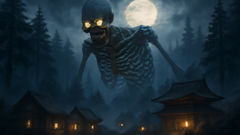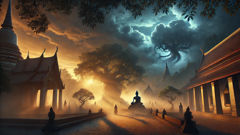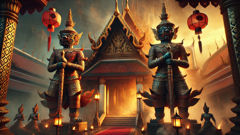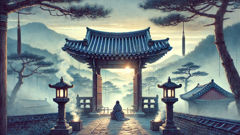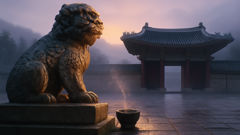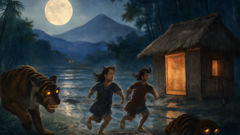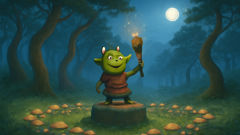Introduction
In the remote valleys of medieval Japan, where mountains cut the horizon into jagged blue silhouettes and the forest’s hush pressed heavy on the heart, hunger often arrived as quietly as the mist. Some seasons, the rice fields yielded little, and river fish grew scarce. Villagers whispered of old ghosts and ill omens, but hunger’s true horror crept into the bones with a slow, gnawing ache. The living gathered each evening by dim candlelight, watching the darkness at the edge of the forest and dreading the cold months to come. Into this world of quiet desperation, the legend of the Gashadokuro was born—a giant skeleton spirit that haunted those who had forgotten the dead. It was said to prowl the outskirts of starving villages, its bony frame towering above the trees, its hollow eye sockets glowing with a pale, unnatural light. Some claimed they heard it before they saw it: the clatter of teeth, the grinding of bones, the faint ring of a warning bell that signaled imminent doom. Others spoke of travelers who vanished on moonless nights, their heads torn clean from their shoulders, their bodies never found. In a land scarred by famine and loss, the Gashadokuro was more than a story to frighten children—it was a terrible truth. For those who perished of starvation, buried without rites, their sorrow and rage congealed in the earth. When suffering became too great, the bones themselves rose up, bound together by a force more dreadful than hunger. This is the tale of Aiko, a village healer whose compassion and courage led her to confront the monstrous spirit. Her journey took her beyond the limits of grief and fear, into the heart of the legend itself. The Gashadokuro was not born of evil, but of neglect—and in the shadows of that ancient forest, the fate of both the living and the dead hung in delicate balance.
Whispers Among the Pines
The autumn wind swept through Narihara village with a mournful sigh, rattling shutters and stirring dry leaves into restless eddies. Hunger had taken root here months before, when a late frost blackened the fields and blight crept through the rice paddies. Now, every home nursed its own emptiness, every table bore silent witness to scarcity. Children grew thin and hollow-eyed; elders stared at the withered sky, remembering kinder years. The village headman, Takeda, rationed what little rice remained, his voice stern but his eyes despairing. At night, villagers gathered in the shrine, praying to the mountain gods for mercy.
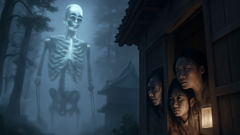
Yet prayers seemed only to deepen the silence. It was in this hush that the first stories began to circulate—soft as moth wings, carried from ear to ear by frightened voices. Aiko, the village healer, listened closely. She had seen more than her share of suffering: mothers clutching infants who would not wake, old men who faded away with the seasons. Her own parents had succumbed to famine years before, their memories a constant ache. She did what she could—brewing bitter teas, binding wounds, comforting the dying. But she could not fill empty bellies.
One evening, as dusk bled into indigo night, Aiko returned from gathering herbs at the forest’s edge. The trees loomed, their trunks black against a bruised sky. She moved quickly, a woven basket on her back, every sense alert. The air felt charged—thick with something unspoken. Suddenly, a sound cut through the hush: a deep, resonant clatter, like wind chimes made of bone. She froze, heart pounding. In the half-light, she saw nothing but twisted branches and drifting mist. But the sound lingered, echoing through the trees.
When she reached the village, Takeda stood waiting, his lantern casting a small pool of gold. “Aiko,” he whispered, eyes darting to the forest, “have you heard what they say? The old stories—of the Gashadokuro.”
She nodded, voice steady. “Only stories, to frighten children.”
He shook his head. “Three travelers vanished on the Kyoto road this week. No sign of them—just scraps of clothing and a trail of broken reeds.”
In the days that followed, fear bloomed like mold. Livestock vanished, and villagers reported seeing a pale glow moving through the forest at midnight. The shrine priest, Hisato, found strange footprints—deep impressions larger than any human’s—at the edge of the rice paddies. Each morning, the village awoke to new losses. The bell at the shrine tolled, not for prayer, but as a warning: stay inside after dark.
Aiko’s sleep grew restless. She dreamed of skeletons rising from shallow graves, their empty eyes pleading for rice and water. Sometimes she awoke to find herself standing at her window, staring into the woods as if called by some distant voice. She began to visit the shrine more often, lighting incense for the unburied dead.
One evening, as she knelt in prayer, Hisato approached. “There’s talk of exorcism,” he said quietly. “But spirits born of hunger are not easily appeased. The Gashadokuro is not a ghost—it’s a curse, a wound that festers when the dead are forgotten.”
Aiko’s resolve hardened. She would not let her village be devoured by fear or by the monstrous thing that stalked their nights. There had to be a way to break the cycle—a way to honor the lost and bring peace to the restless bones. In the silence that followed Hisato’s words, she made a vow: she would uncover the truth behind the legend and, if she could, confront the Gashadokuro itself.
The Hungry Dead Rise
The days grew colder, sharpening hunger’s bite. Word of the Gashadokuro’s presence spread beyond Narihara. Merchants from neighboring villages refused to travel the old forest road. Superstitions flared—children wore red strings around their wrists to ward off evil, and elders hung bones of wild boar above doorways as talismans.
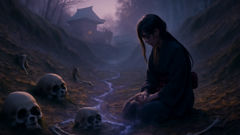
Aiko’s own skepticism wavered in the face of mounting evidence. She heard the midnight clatter herself—louder now, as if the thing in the forest was drawing closer. Some nights, a chill settled over the village, unnatural and sudden, as though a vast shadow passed overhead. Dogs cowered and howled at nothing. Livestock refused to graze near the woods.
Then, in the first week of November, the Gashadokuro was seen. The moon was new, the sky a cold bowl of blackness. Takeda’s nephew, Hiro, ventured out after dark to check on a missing goat. He never returned. In the morning, villagers found his sandals and a scattering of teeth beside a crushed patch of reeds. In the soft mud lay a single, gigantic footprint—five times the size of a man’s.
Panic took root. Some families packed what they could and fled to distant relatives. Others barricaded themselves indoors, refusing to speak of what they’d seen. But Aiko remained, gathering what little courage she could muster. She questioned the few who dared approach her clinic. An old woman described a dream: a sea of bones rising from the earth, forming a giant that drank the tears of the living. A child insisted he’d seen a lantern swinging high among the treetops, then heard a voice that sounded like a hundred jaws chattering in unison.
Desperate for answers, Aiko visited Hisato at the shrine. By the glow of votive candles, he pulled down an ancient scroll—a record from a famine centuries earlier. The ink was faded, but she could just make out the illustration: a skeletal giant with lantern eyes, striding across a devastated field. The accompanying text spoke of appeasement: “When the hungry dead are honored, their rage is soothed. Neglect them, and they rise.”
Aiko pieced together what she could. The Gashadokuro was not a single spirit, but an amalgamation—born from the bones of those who died nameless, unburied, forgotten. Each famine left its mark on the land, and in times of great suffering, those marks coalesced into vengeance. The monster was both warning and consequence.
That night, as she lay awake listening to the hush outside, Aiko resolved to find where the Gashadokuro had formed. She recalled a ravine on the forest’s northern edge—a place children avoided, where wildflowers refused to grow. Old stories called it ‘The Valley of Hungry Ghosts.’ She would go there at dawn, seeking the roots of the legend.
At first light, Aiko set out, carrying only her herb pouch and a bell borrowed from the shrine. The forest was dense, its silence broken only by her footsteps and the distant cry of crows. She followed an animal path, passing twisted roots and stones stained with ancient moss. The air grew colder as she neared the ravine.
She found it at last: a shallow depression choked with dead leaves, ringed by crooked stones. The earth had been disturbed here—mounds rising and falling in irregular patterns. Kneeling, she brushed away soil with trembling hands. Beneath her fingers, bone met bone. Skulls, femurs, rib cages—all jumbled together in a silent chorus of suffering.
As she touched them, a wave of grief flooded her—a sense of hunger so deep it threatened to consume her mind. Voices echoed in her head, pleading for remembrance. She rang the bell, its clear note piercing the morning. As it faded, the air seemed to grow heavier, as if something vast and ancient stirred beneath her feet.
A Pact of Remembrance
The bell’s chime lingered in the air as Aiko knelt in the ravine, surrounded by the remains of famine’s forgotten dead. The sense of sorrow was overwhelming—her breath caught as waves of hunger, cold, and loneliness washed through her soul. In that moment, she understood: the Gashadokuro was not merely a monster, but an embodiment of every unremembered soul, every life lost to neglect and despair.
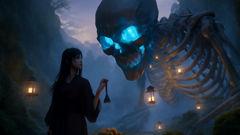
She closed her eyes and spoke softly, her words trembling but clear: “I see you. I remember you. May you know peace.”
The wind picked up, carrying her voice through the trees. For a moment, nothing happened. Then, from deep within the ravine, a faint glow began to pulse—blue and unearthly, as if a hundred tiny lanterns had flickered to life beneath the ground. The bones shifted, grinding together in slow motion. Aiko gasped and stumbled back as skeletal fingers curled from the soil, grasping at nothing.
Suddenly, she was not alone. The towering figure of the Gashadokuro emerged from the mist at the ravine’s edge. It was as tall as the tallest pine—its bones bleached white, its eyes burning with cold fire. It stared down at her, jaw working in silent fury. Every step it took made the earth tremble.
Aiko faced it, her heart hammering. “You are born from pain,” she said. “But you do not have to be our enemy.”
The Gashadokuro paused, head cocked as if listening. The teeth clattered—a sound both mournful and enraged. Aiko remembered Hisato’s words: spirits born of hunger are not easily appeased. But perhaps they could be understood.
She raised the bell and rang it again. The clear note rang out, steady and strong. “I will honor you,” she promised. “I will give you names.”
The giant skeleton crouched low, bringing its skull level with hers. Its breath was icy—every exhale carrying the scent of earth and decay. But in its eyes, Aiko saw something else: longing.
She spoke the names of those she remembered—the children lost last winter, her parents, the villagers who had faded away in silence. For each name, she placed an offering: a sprig of rice, a cup of water, a folded paper crane. The Gashadokuro’s bones rattled softly, and the glow in its eyes flickered.
As dawn brightened, the monster rose to its full height and stepped back into the mist. The bones in the ravine settled. The wave of grief eased, replaced by a fragile sense of peace.
Aiko returned to Narihara, gathering villagers in the shrine to tell them what she had seen. Some wept openly; others could barely meet her gaze. But as the story spread, fear gave way to action. The villagers began to hold ceremonies for the unburied dead—lighting lanterns, singing mourning songs, placing offerings at every crossroads and field.
With each rite, the sense of dread that hung over Narihara diminished. The midnight clatter faded. The livestock returned. By winter’s end, no more travelers vanished, and the forest grew quiet again.
But the legend endured. Each spring, Aiko led a procession into the Valley of Hungry Ghosts, honoring the lost with incense and song. She understood now: remembrance was a pact, a promise that hunger and neglect would never again be allowed to breed monsters in silence.
Conclusion
The legend of the Gashadokuro lingers long after famine fades and forests reclaim their quiet. In Narihara, memory became ritual—a way to bind the wounds of loss and hunger so they would not fester into something monstrous. The giant skeleton spirit was never seen again in its terrible form, but villagers knew it remained—a guardian and a warning, both. Aiko’s courage transformed despair into remembrance, teaching her people that honoring the lost was not only an act of compassion but a shield against the darkness bred by neglect. Each year, as spring buds opened and rice shoots sprouted in muddy fields, bells rang in the Valley of Hungry Ghosts. Lanterns bobbed among the pines, their warm glow promising that no one would be forgotten. In this way, the Gashadokuro’s hunger was finally stilled—not by fear or violence, but by the simple power of memory. The legend endures because it is true: when grief is left to rot in silence, it grows teeth. But when sorrow is named and remembered, even the hungriest spirits can find peace.

